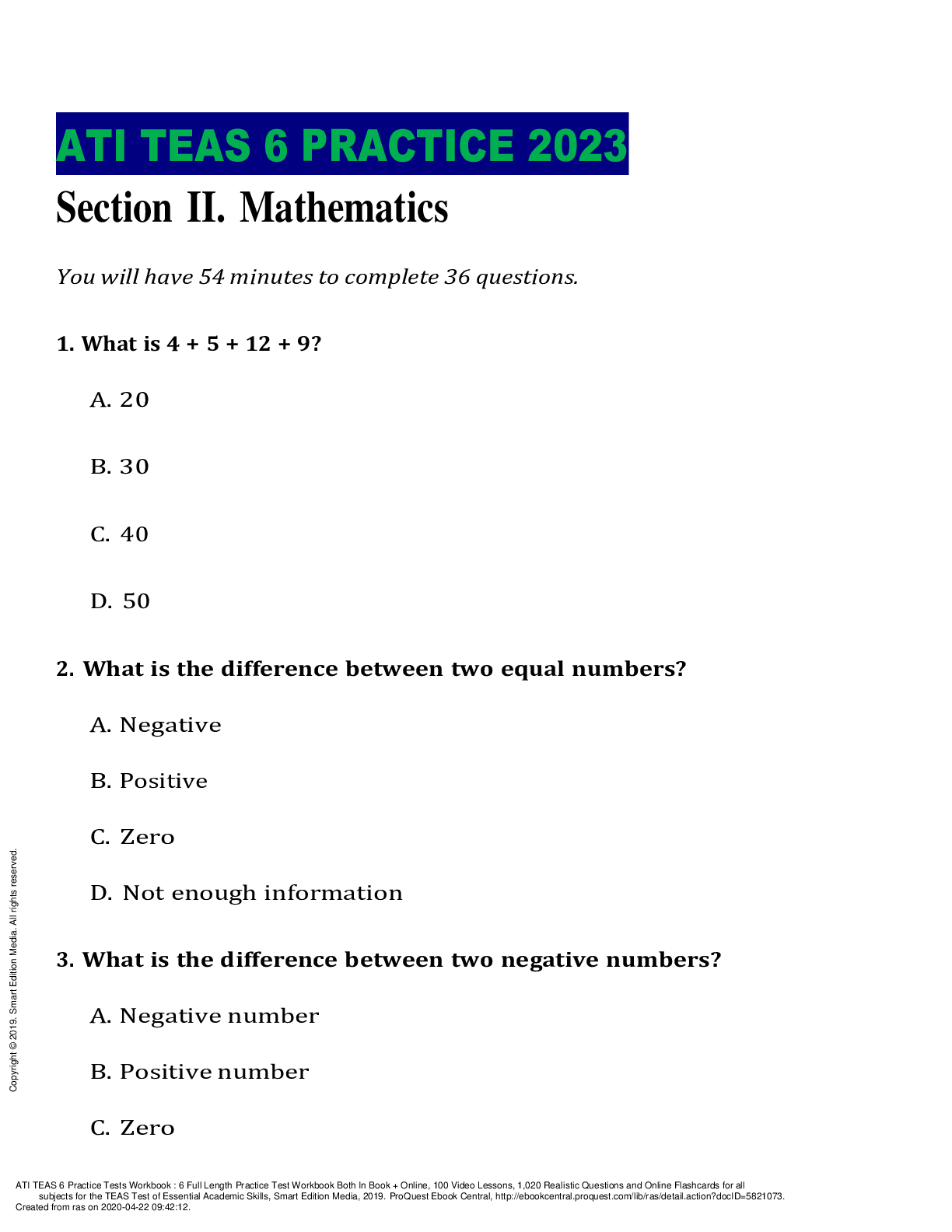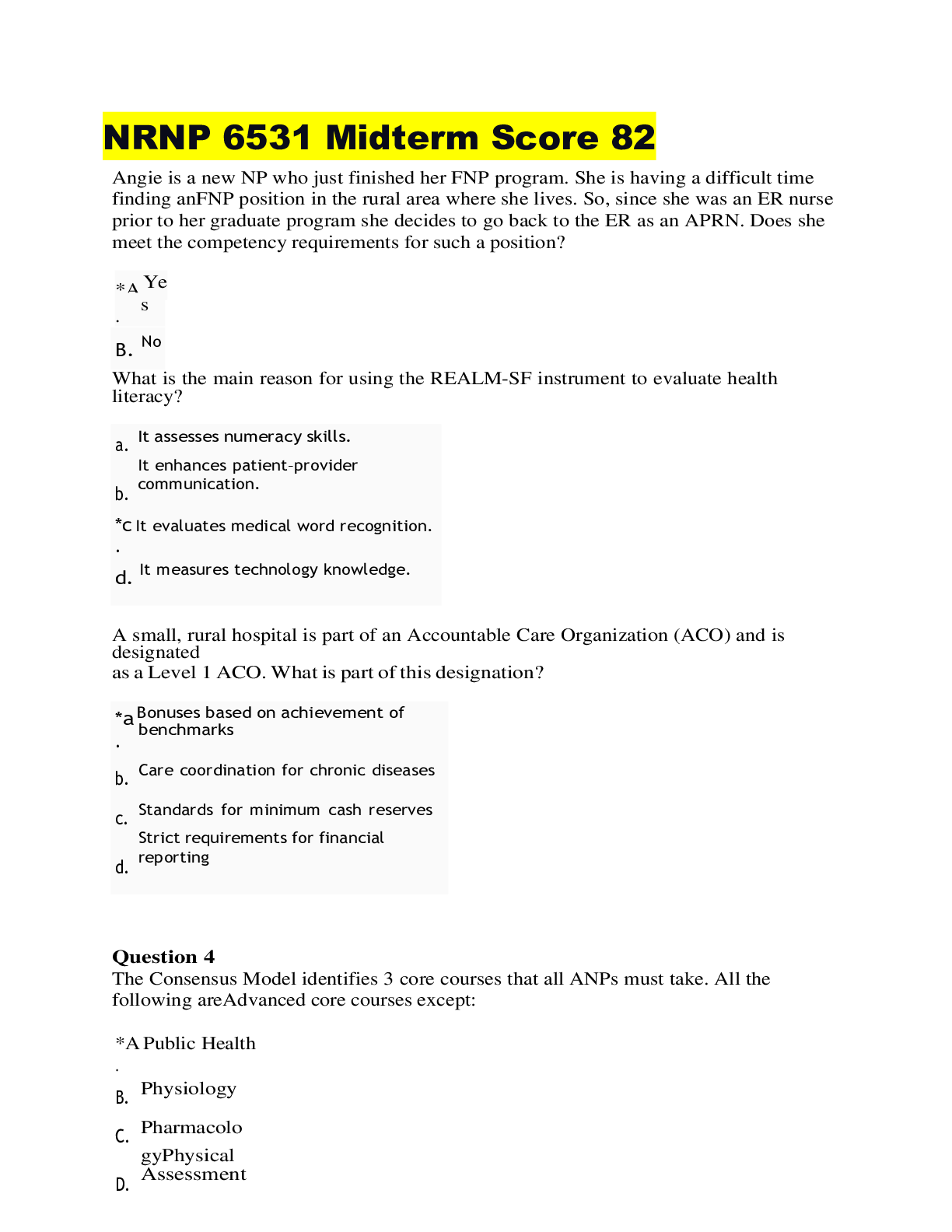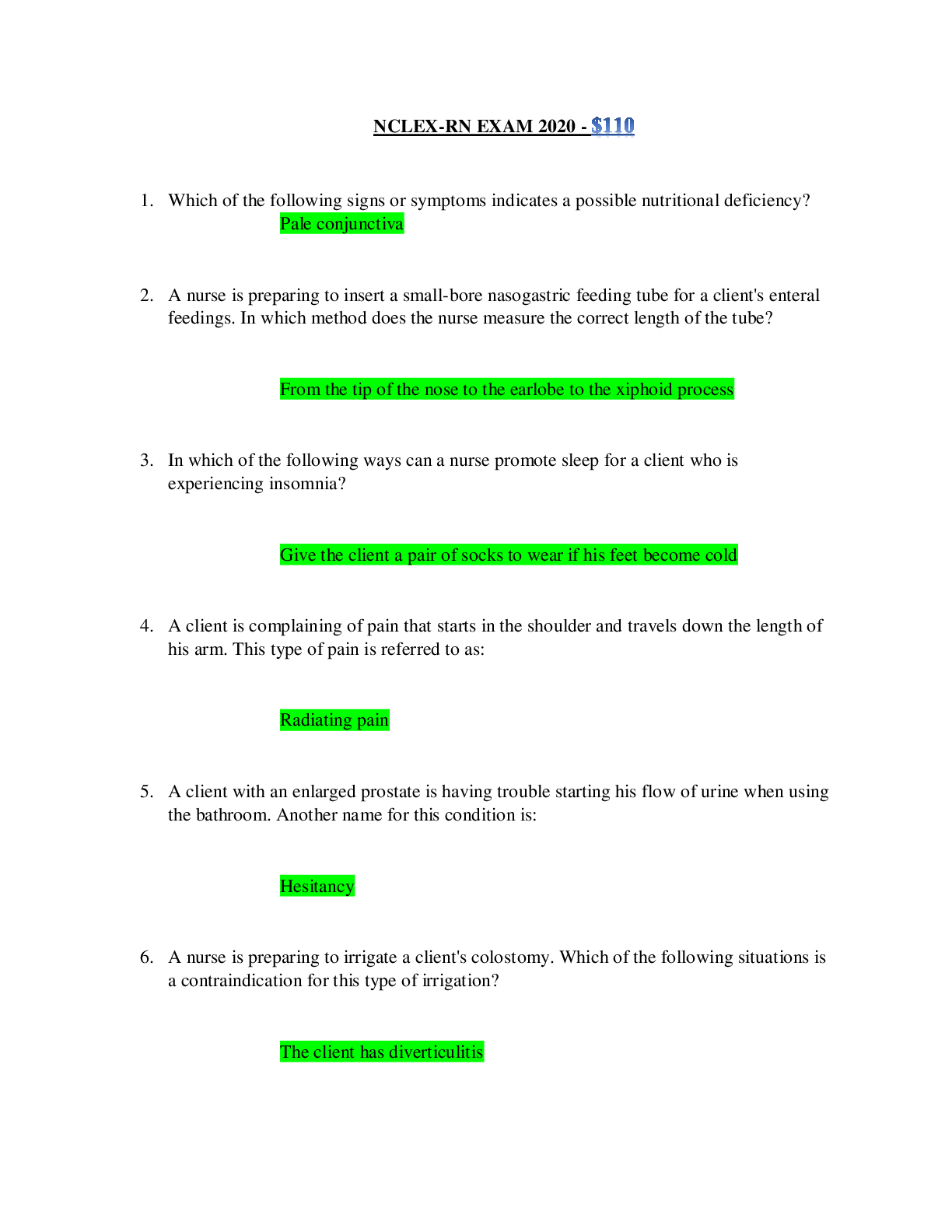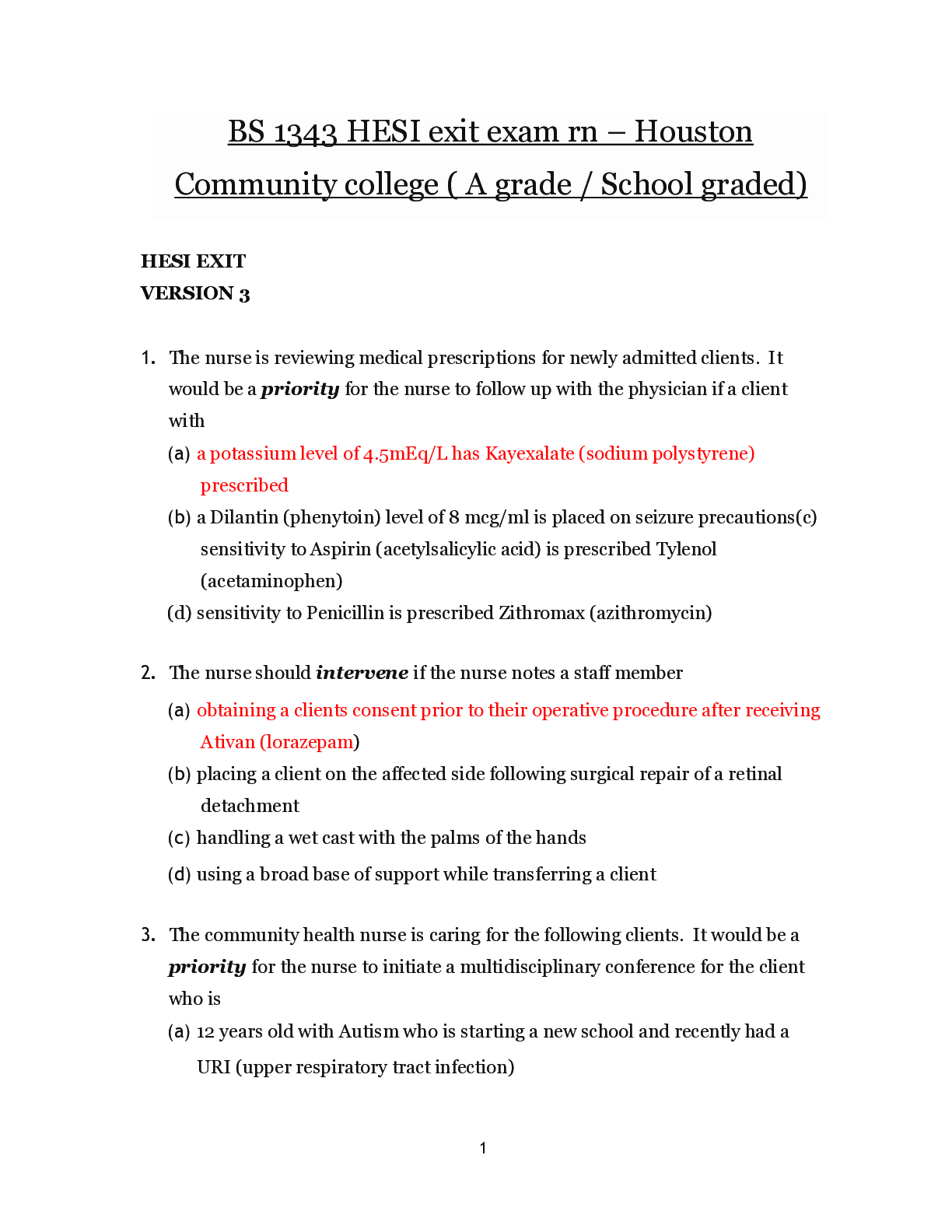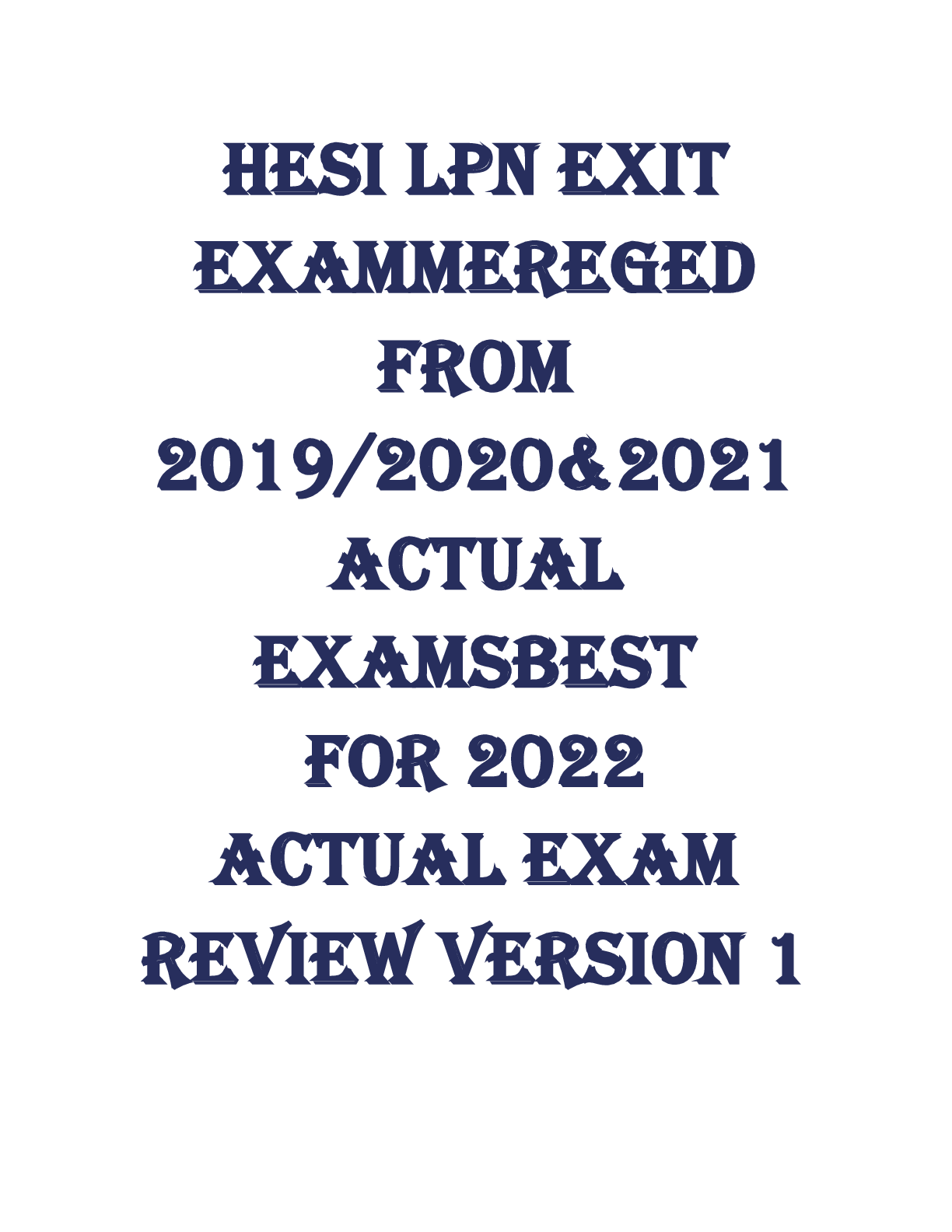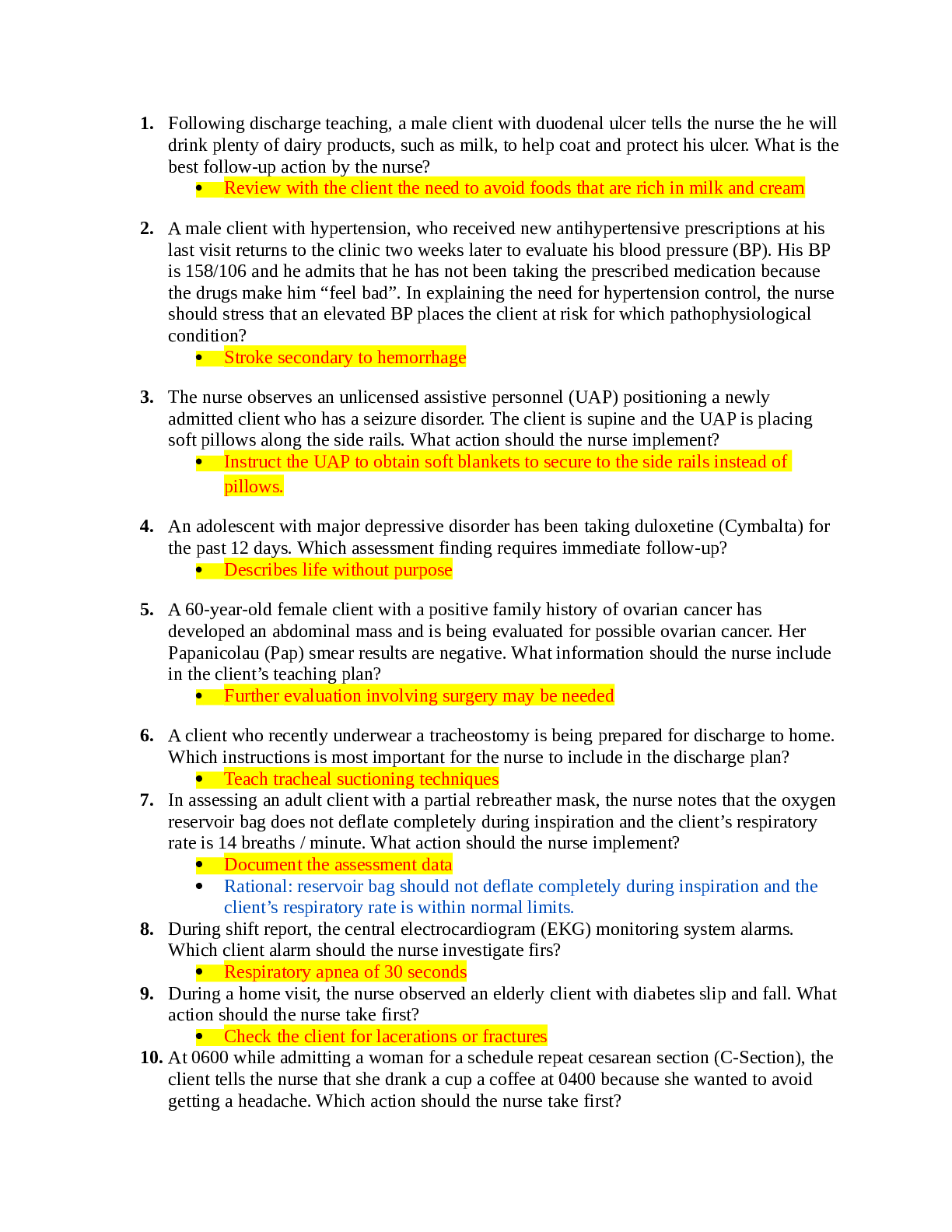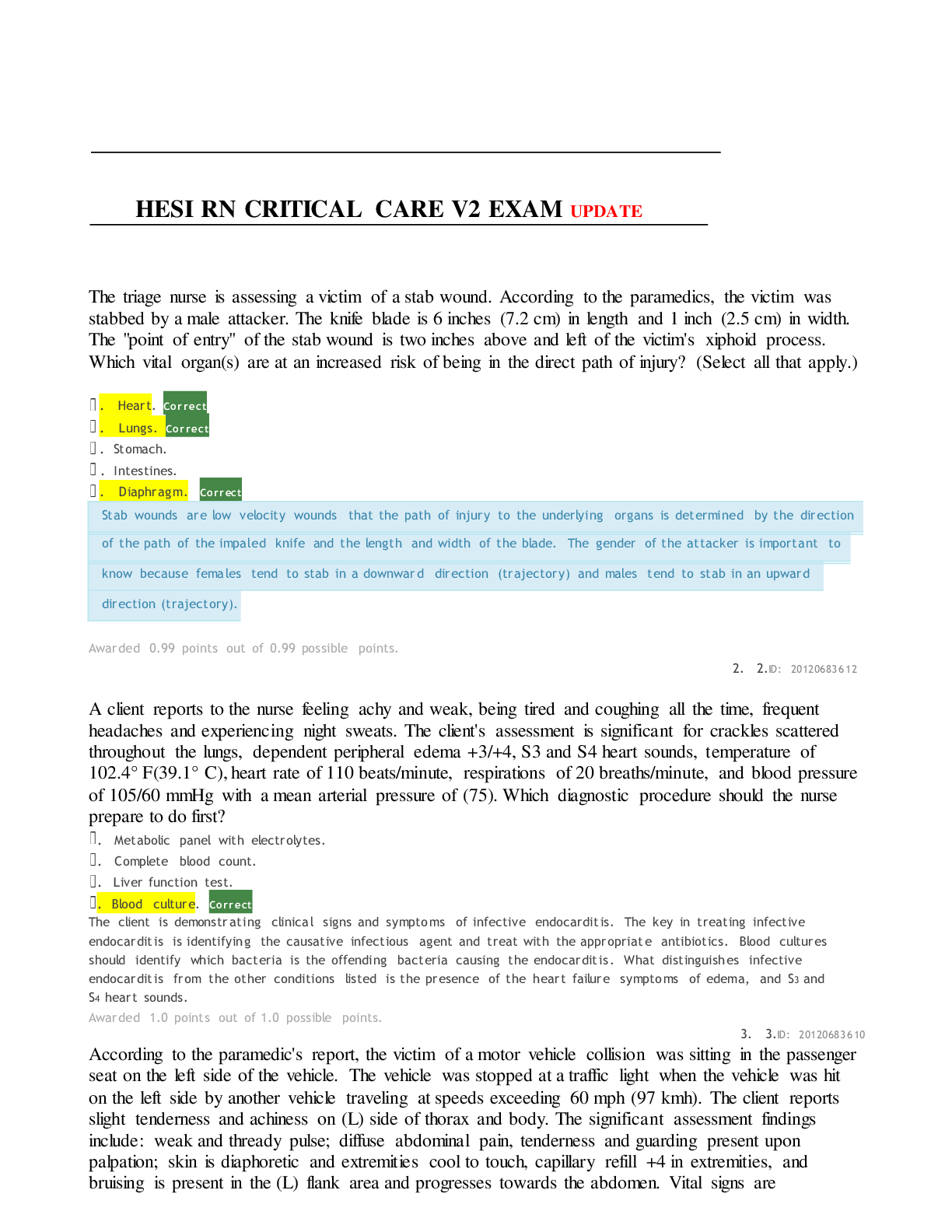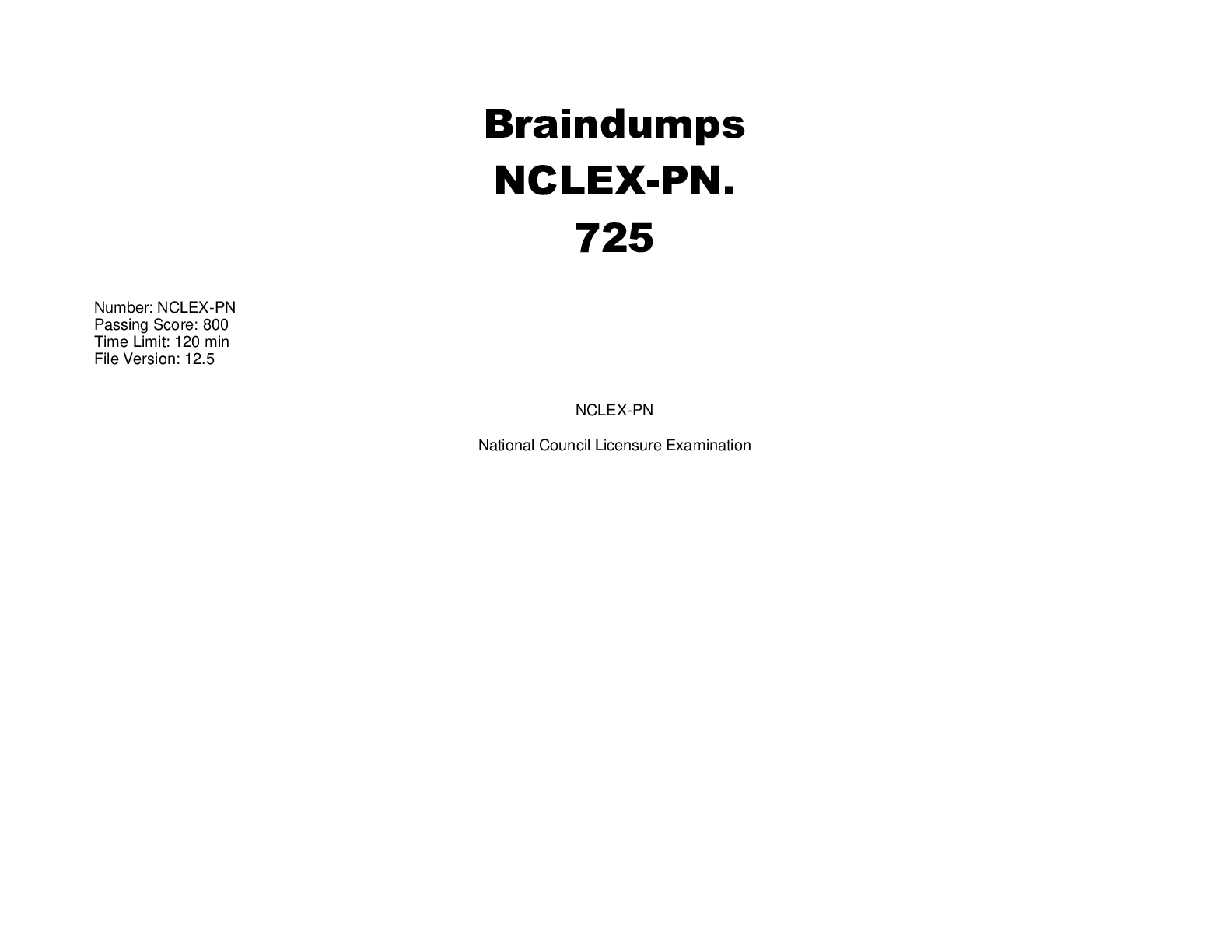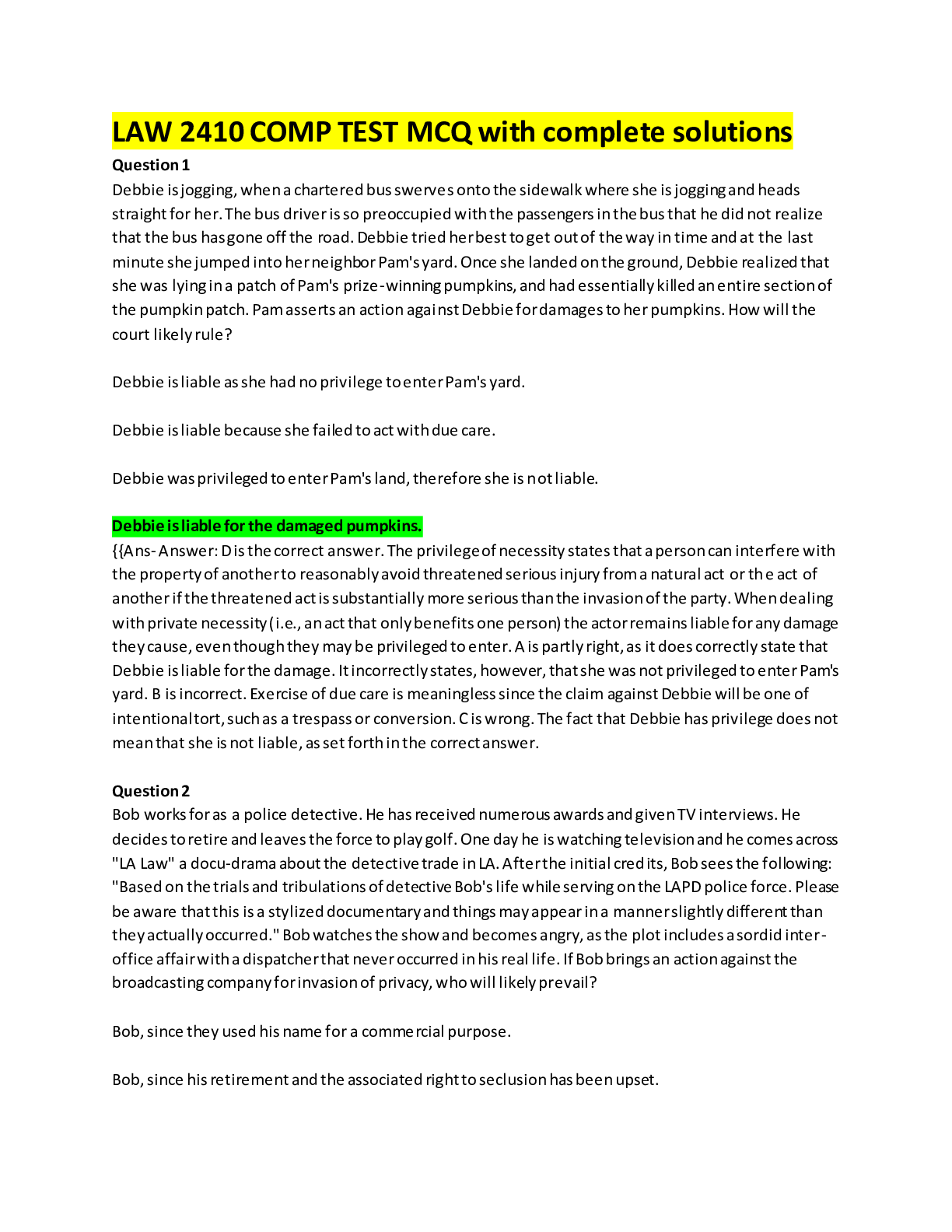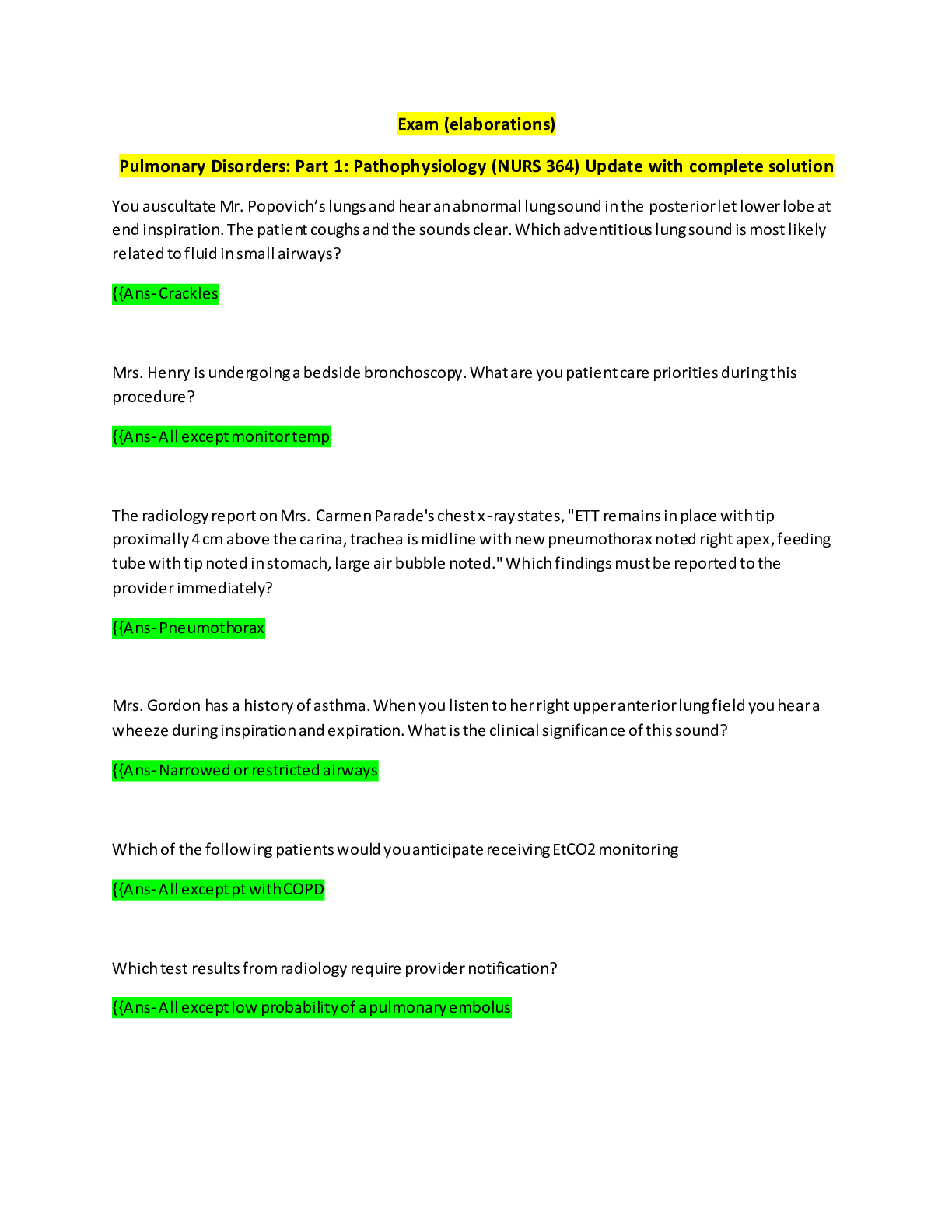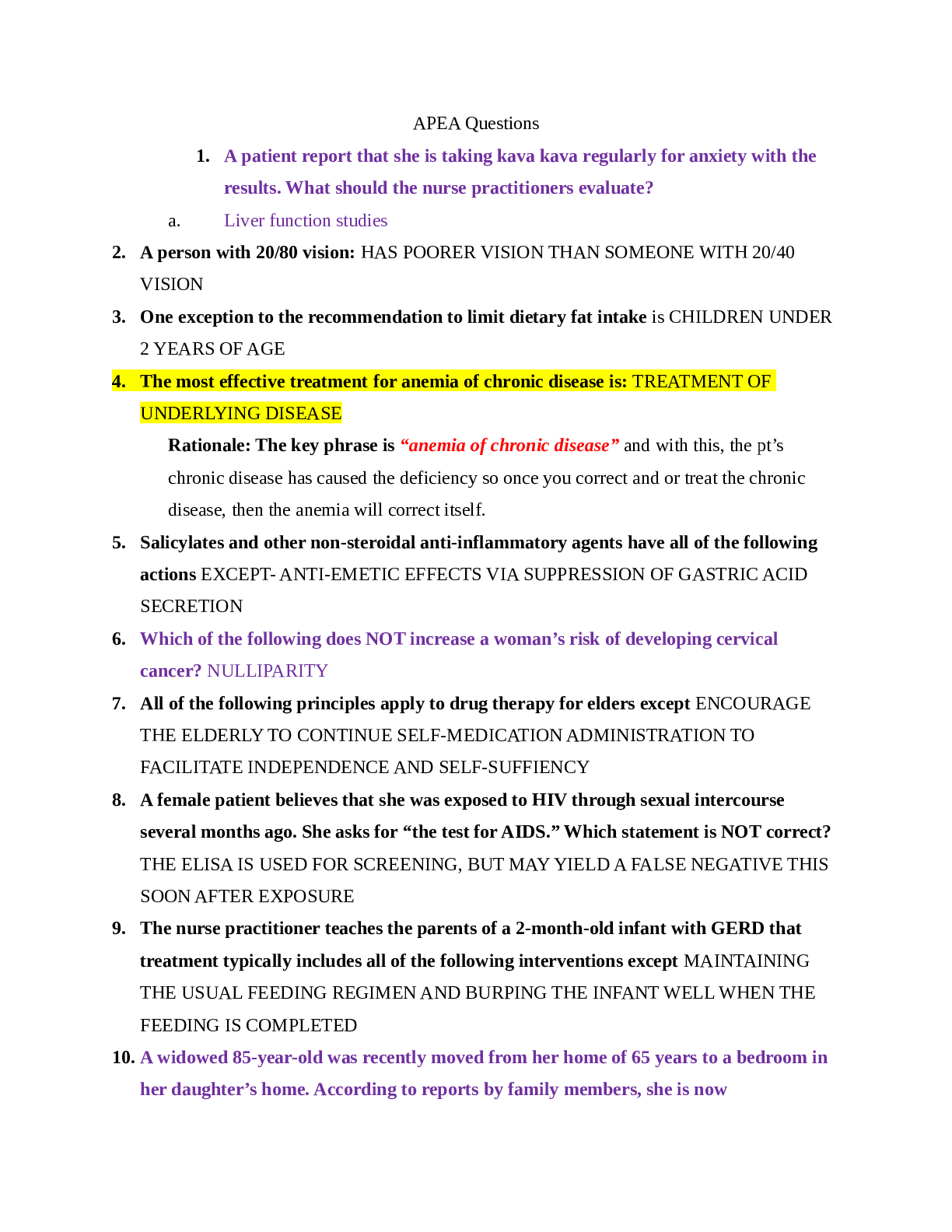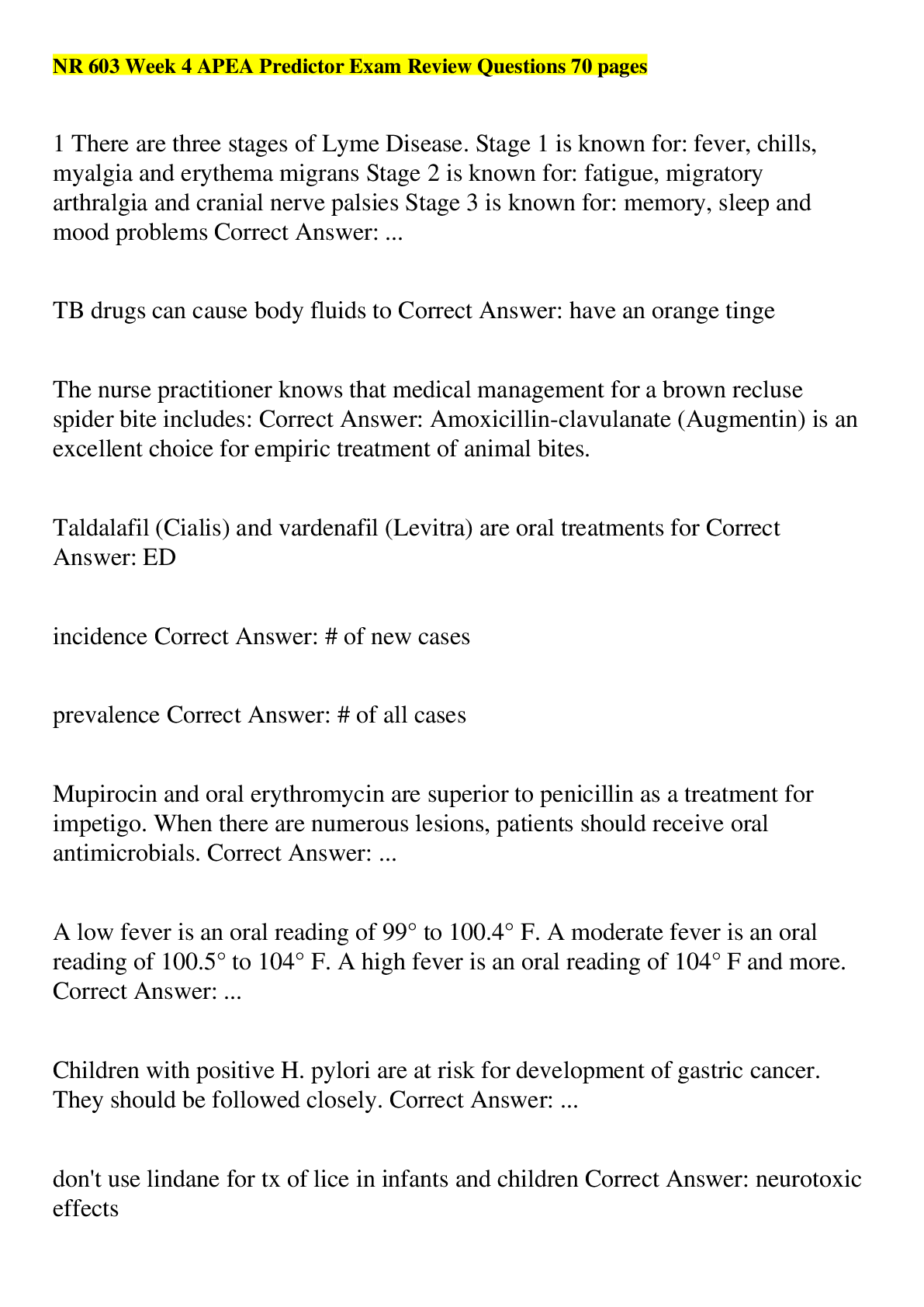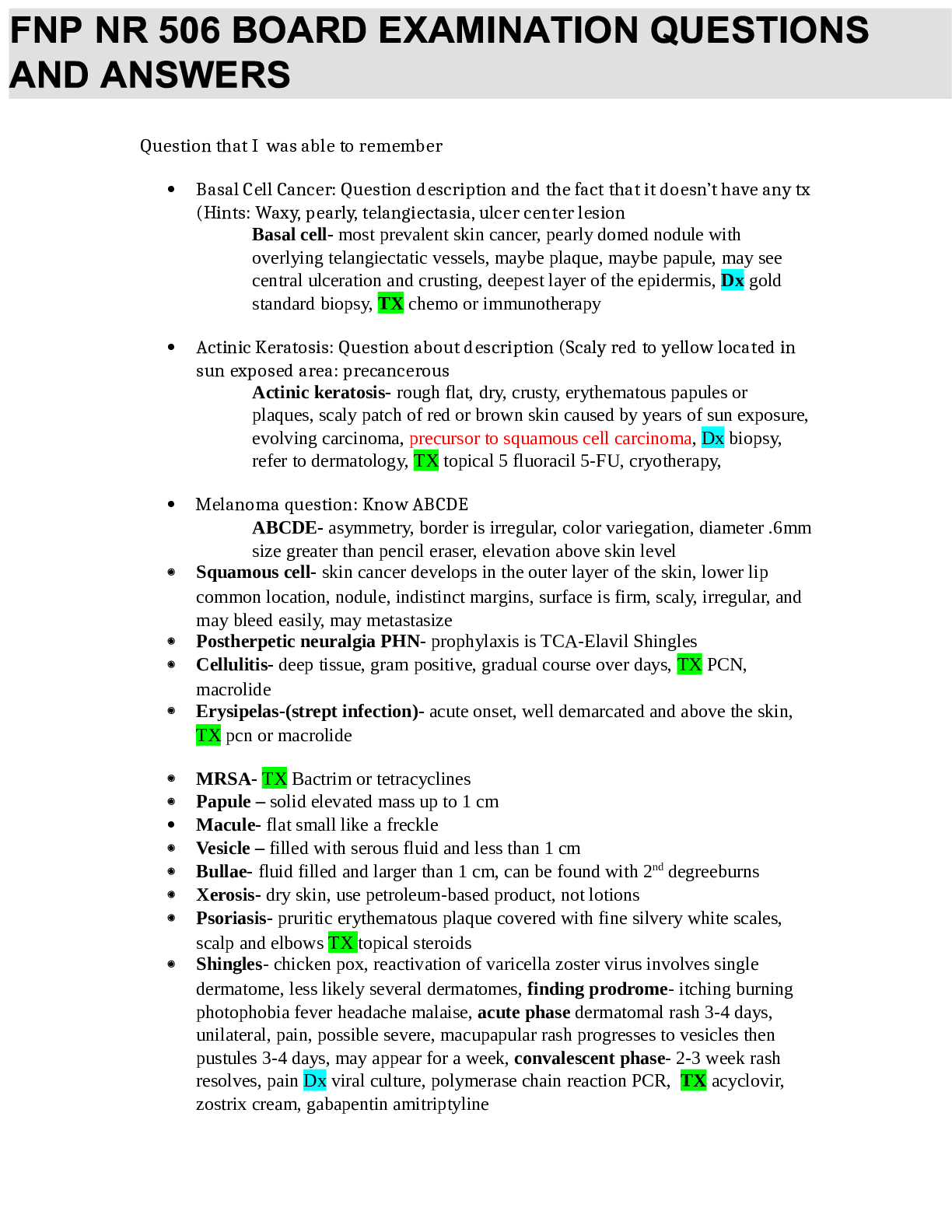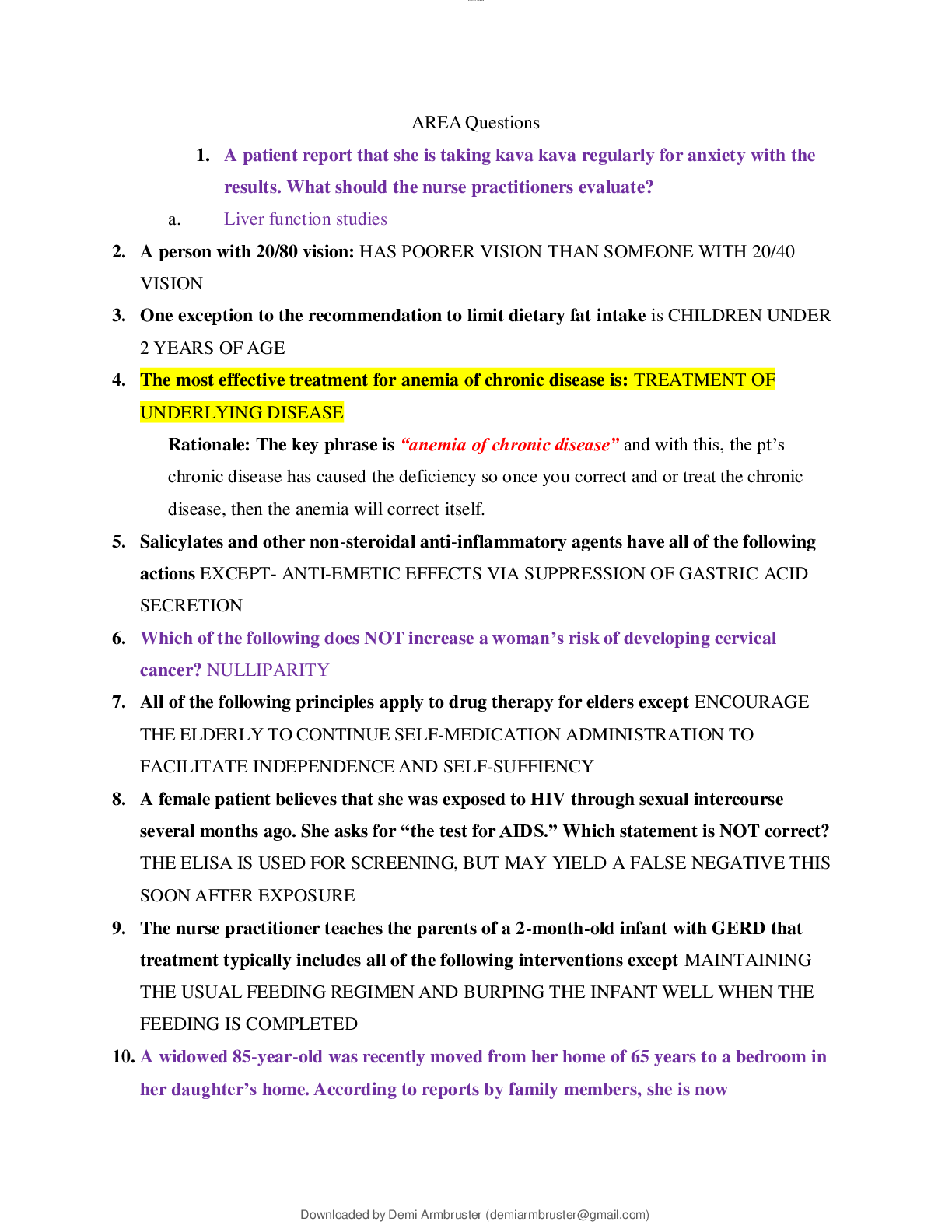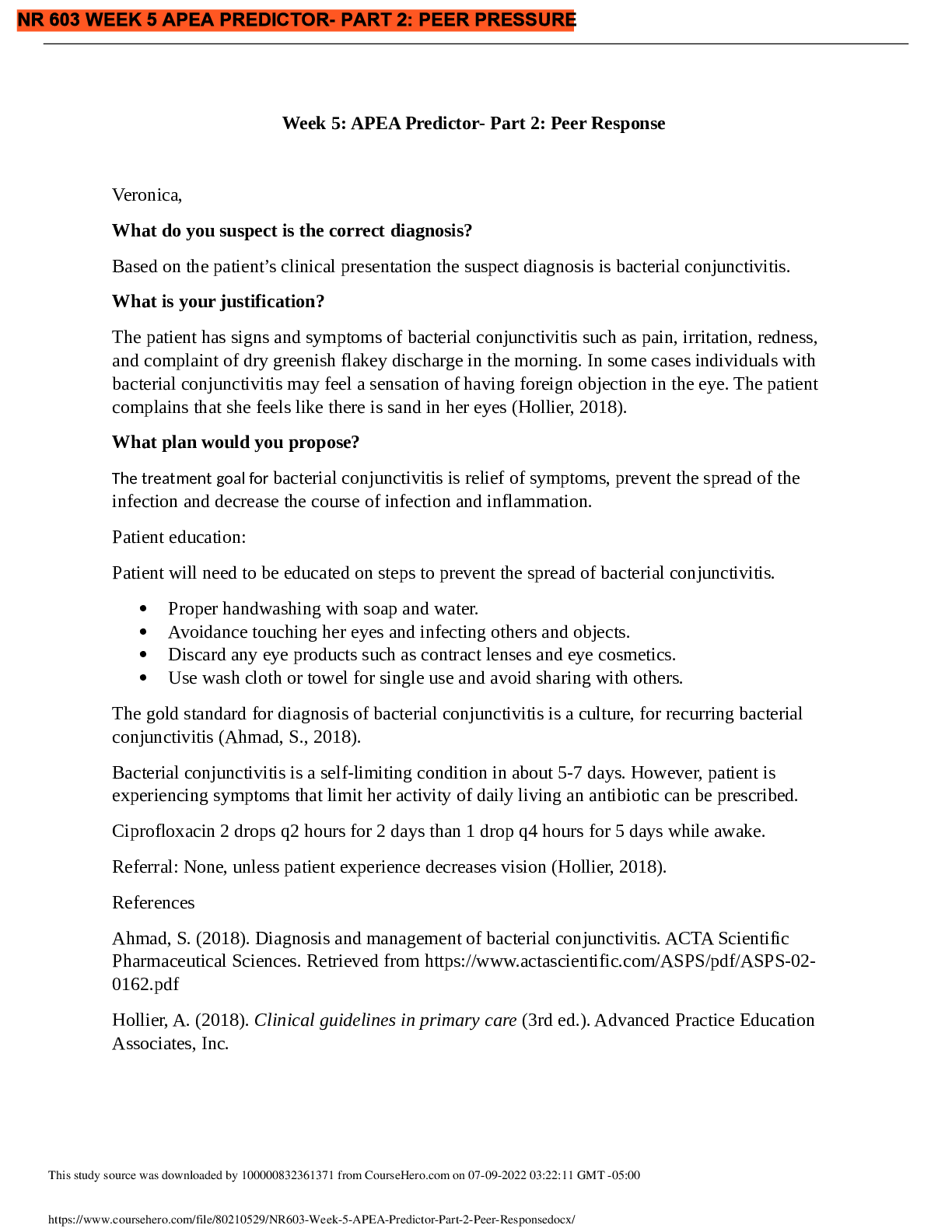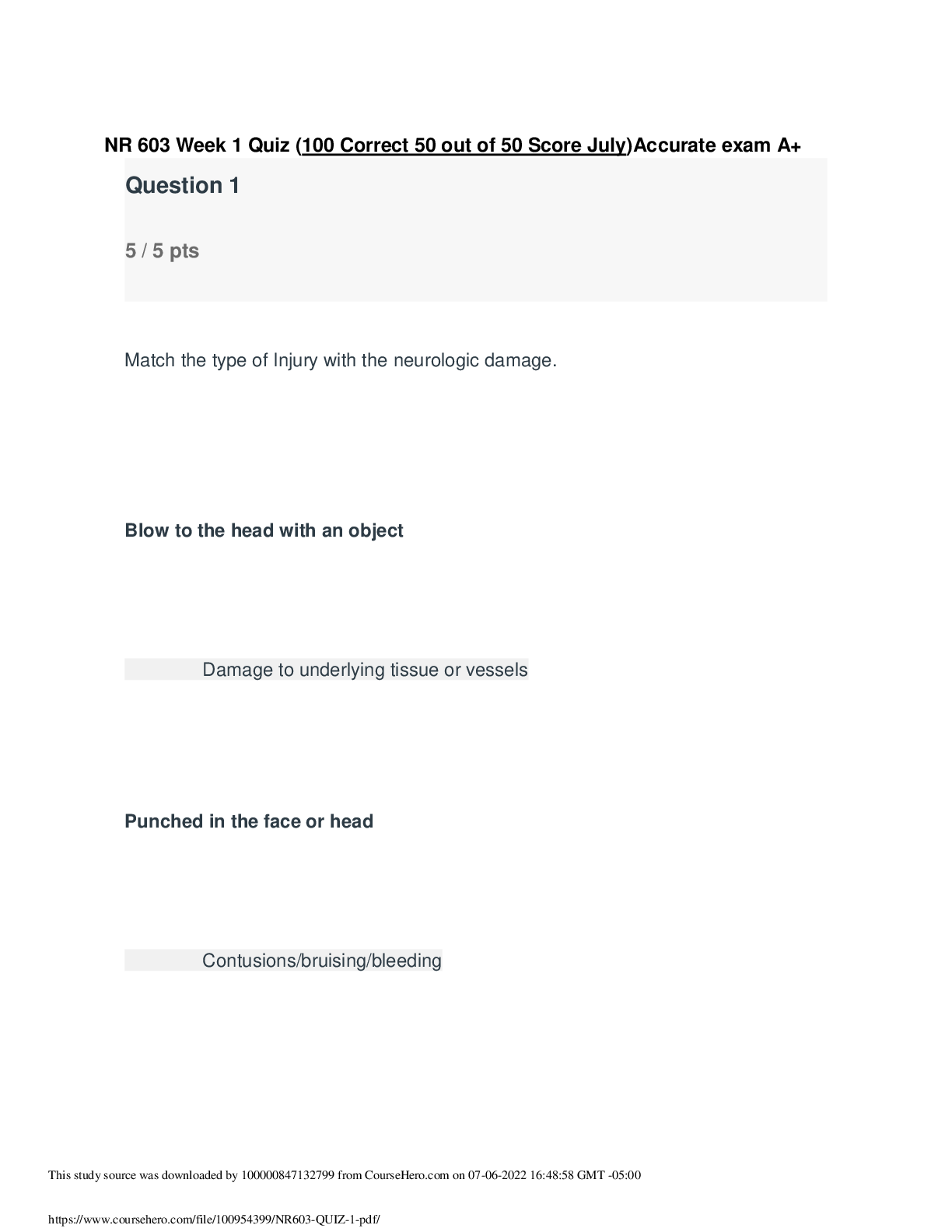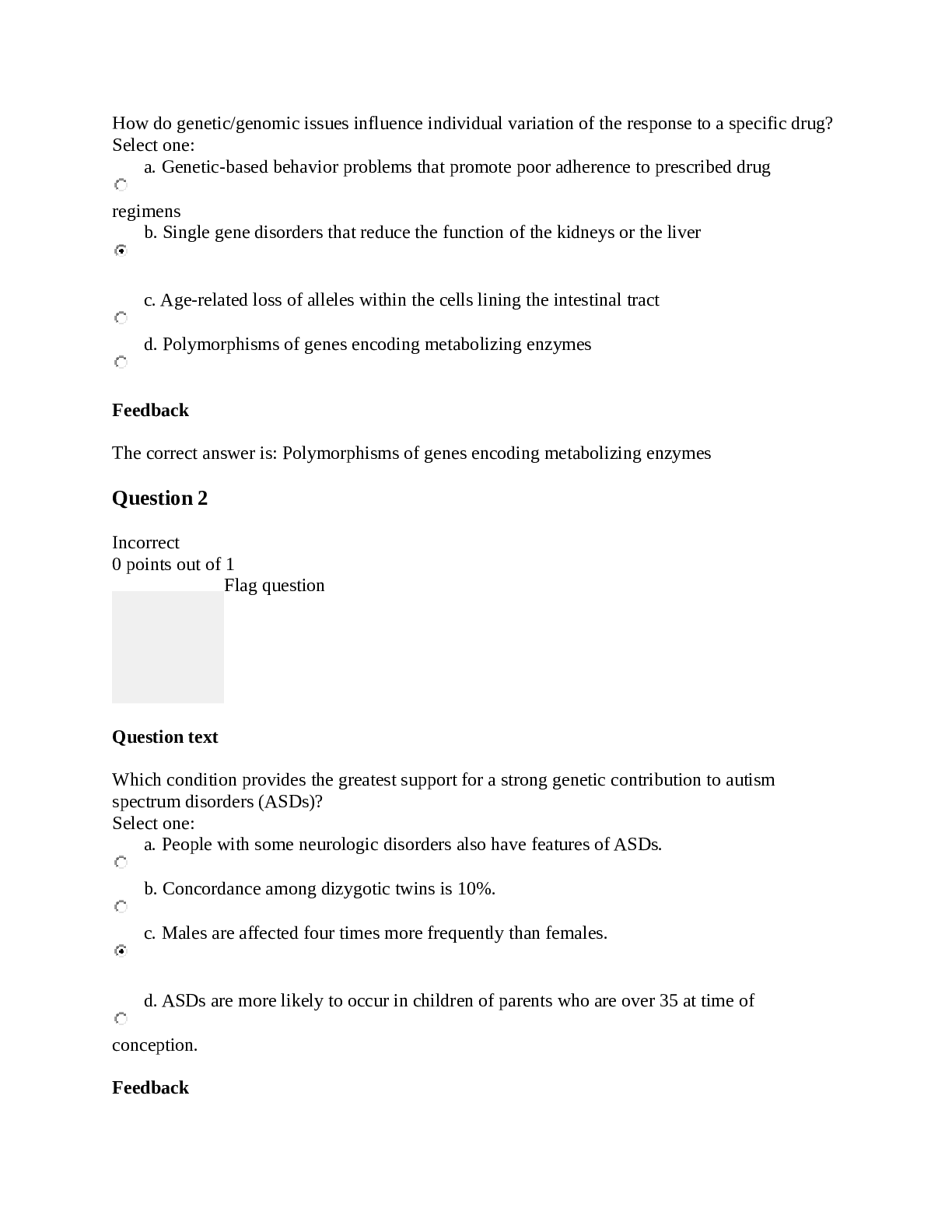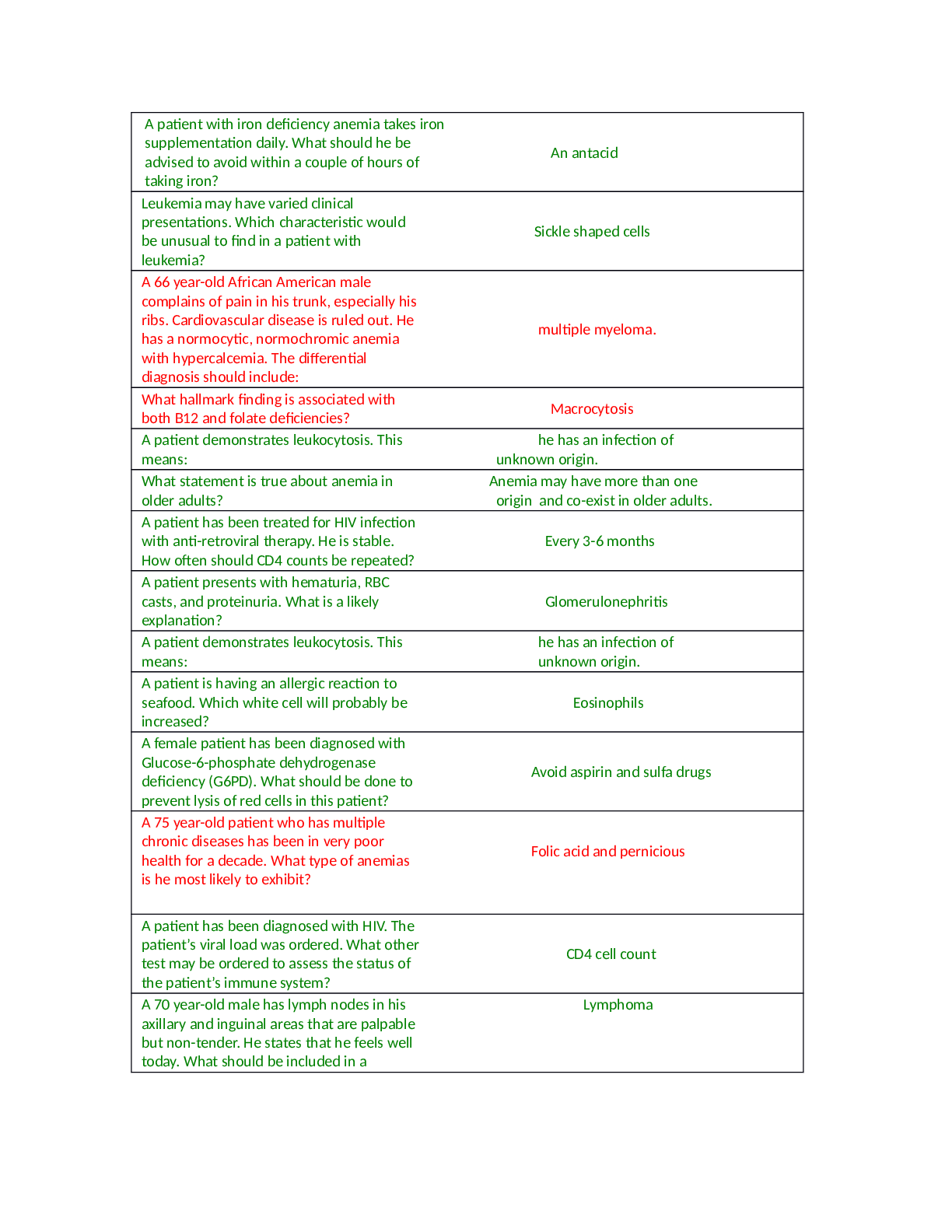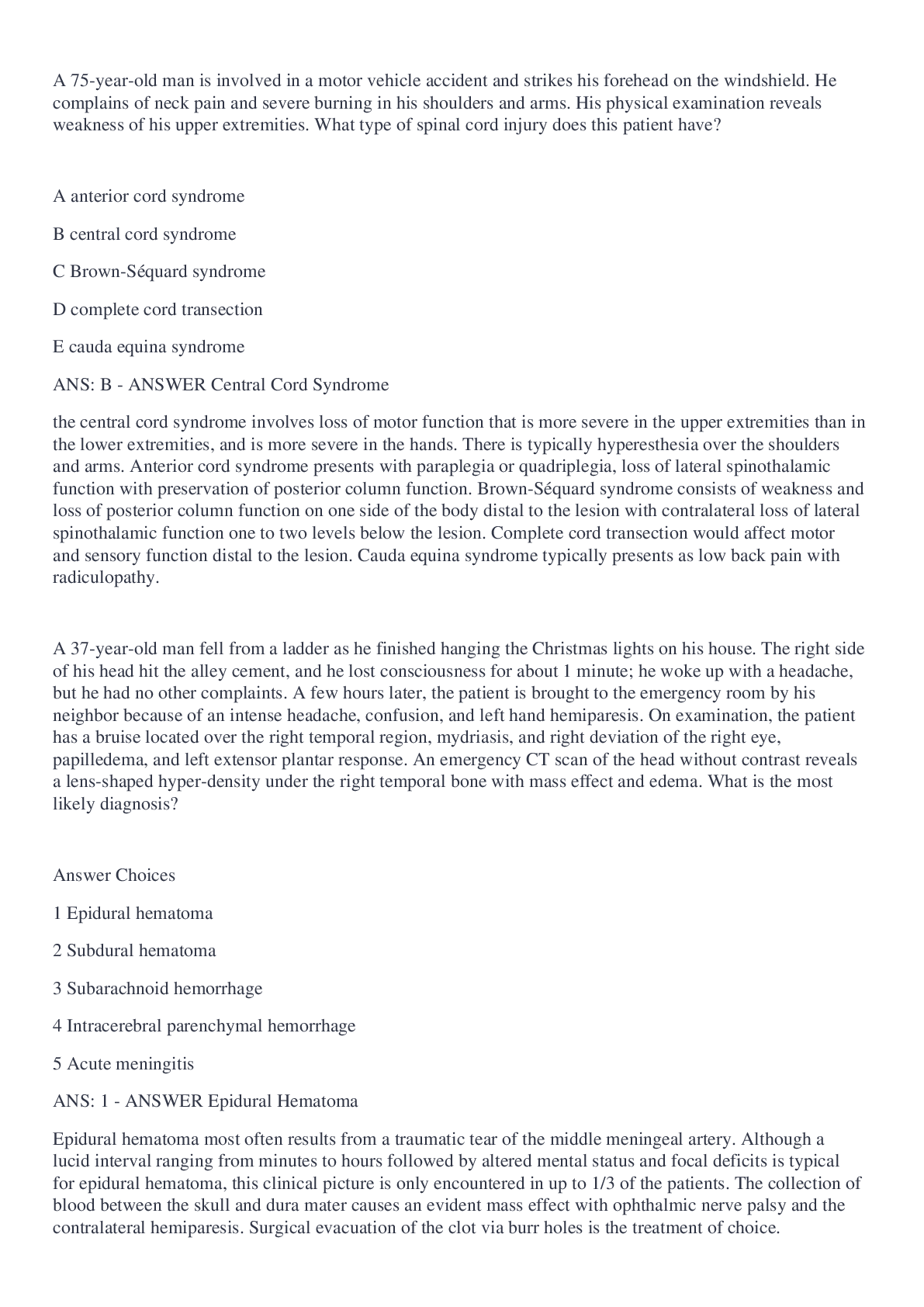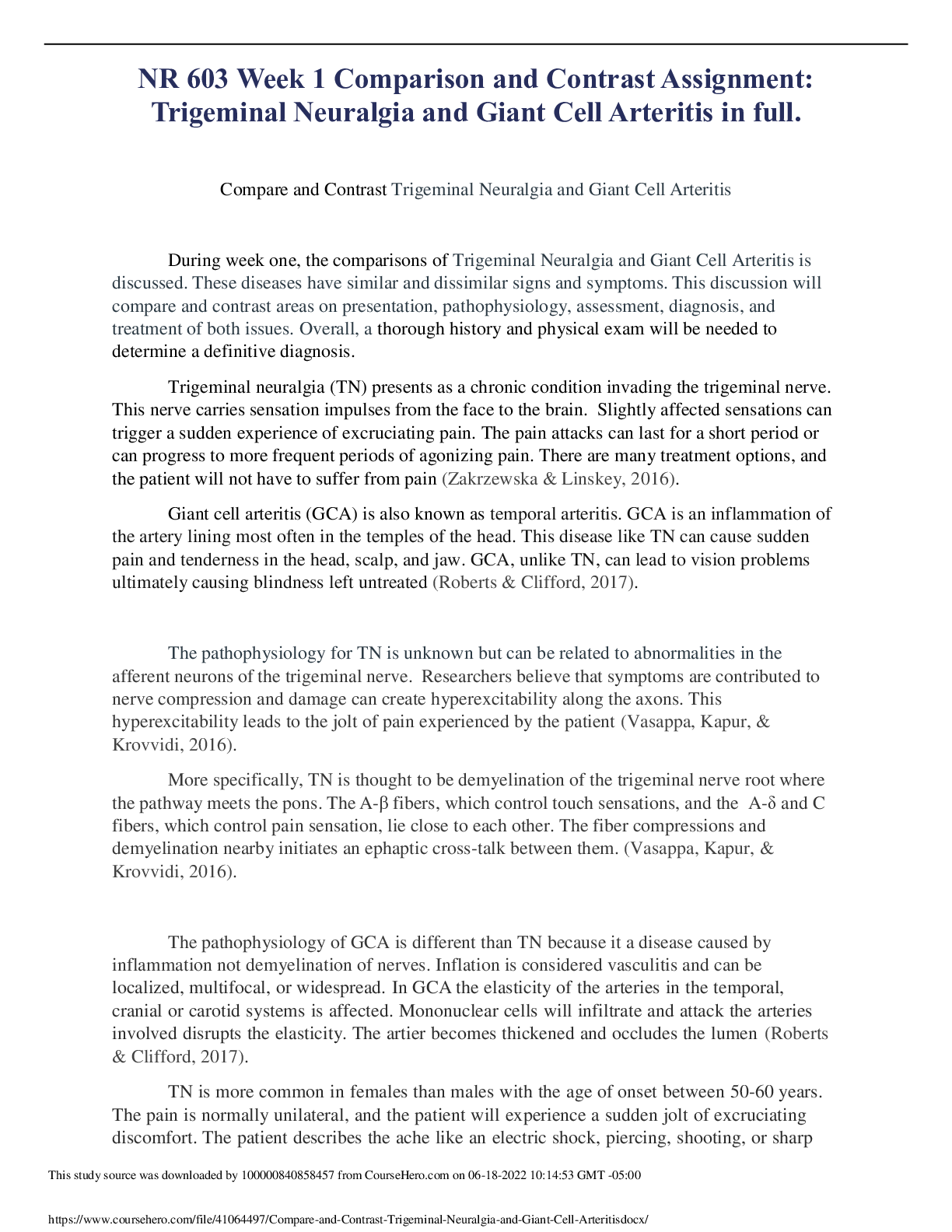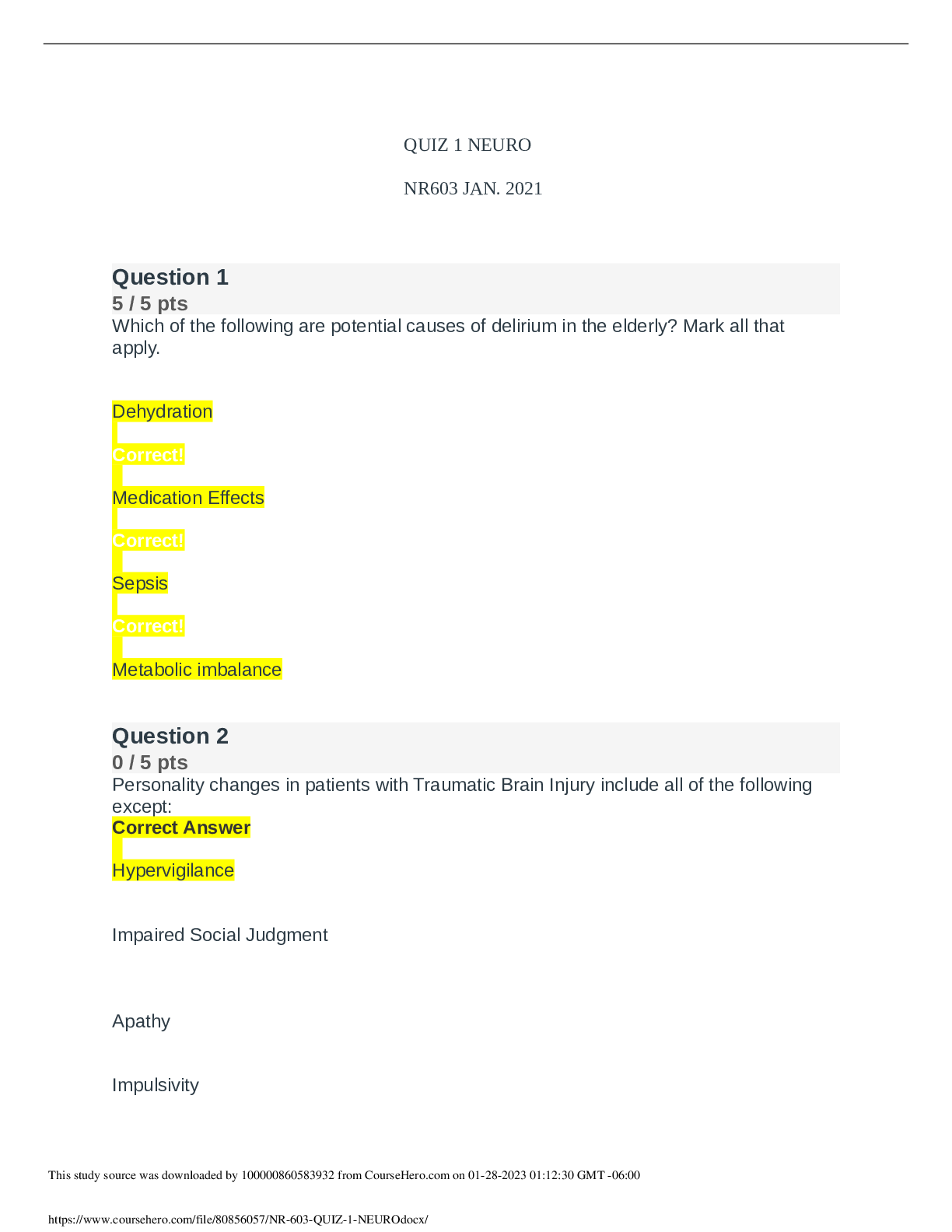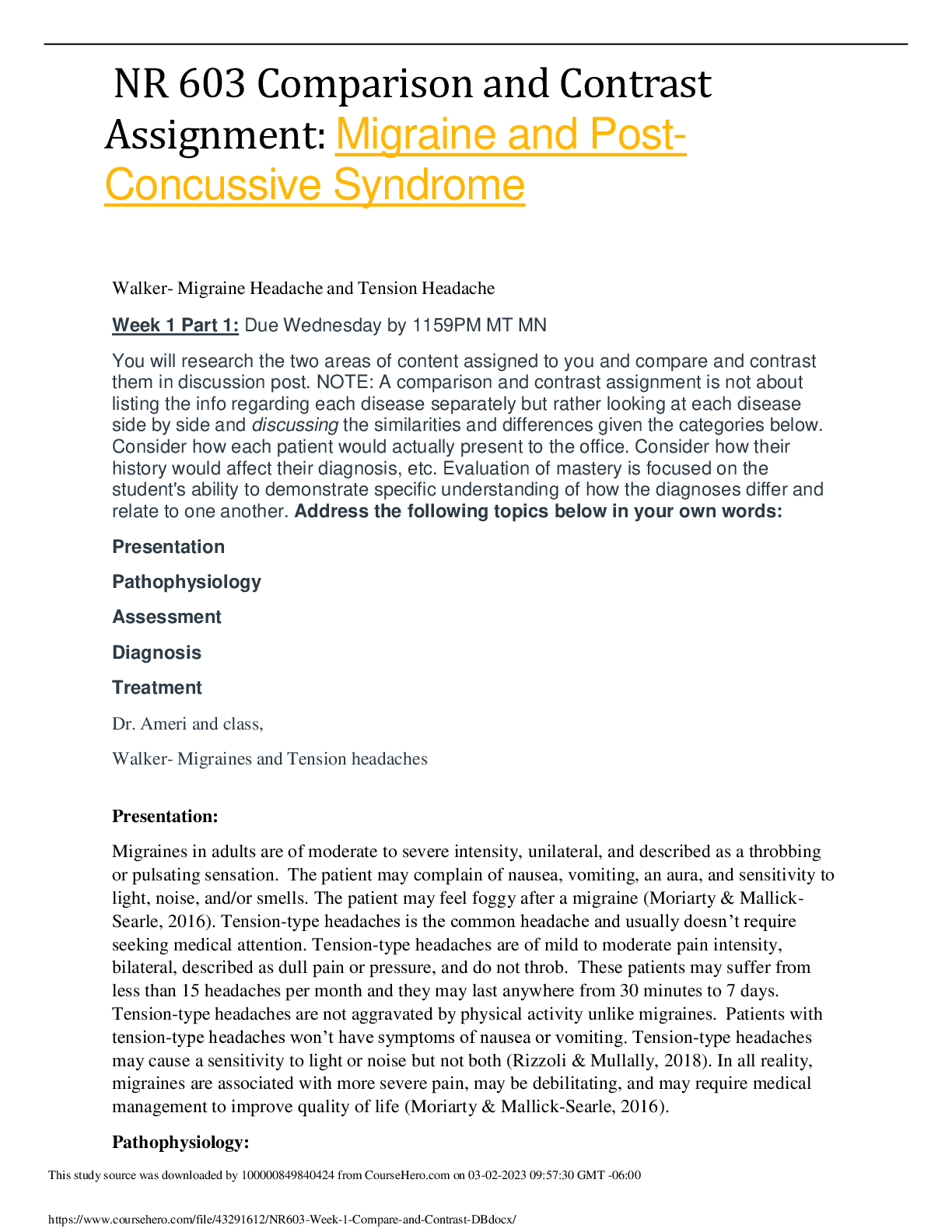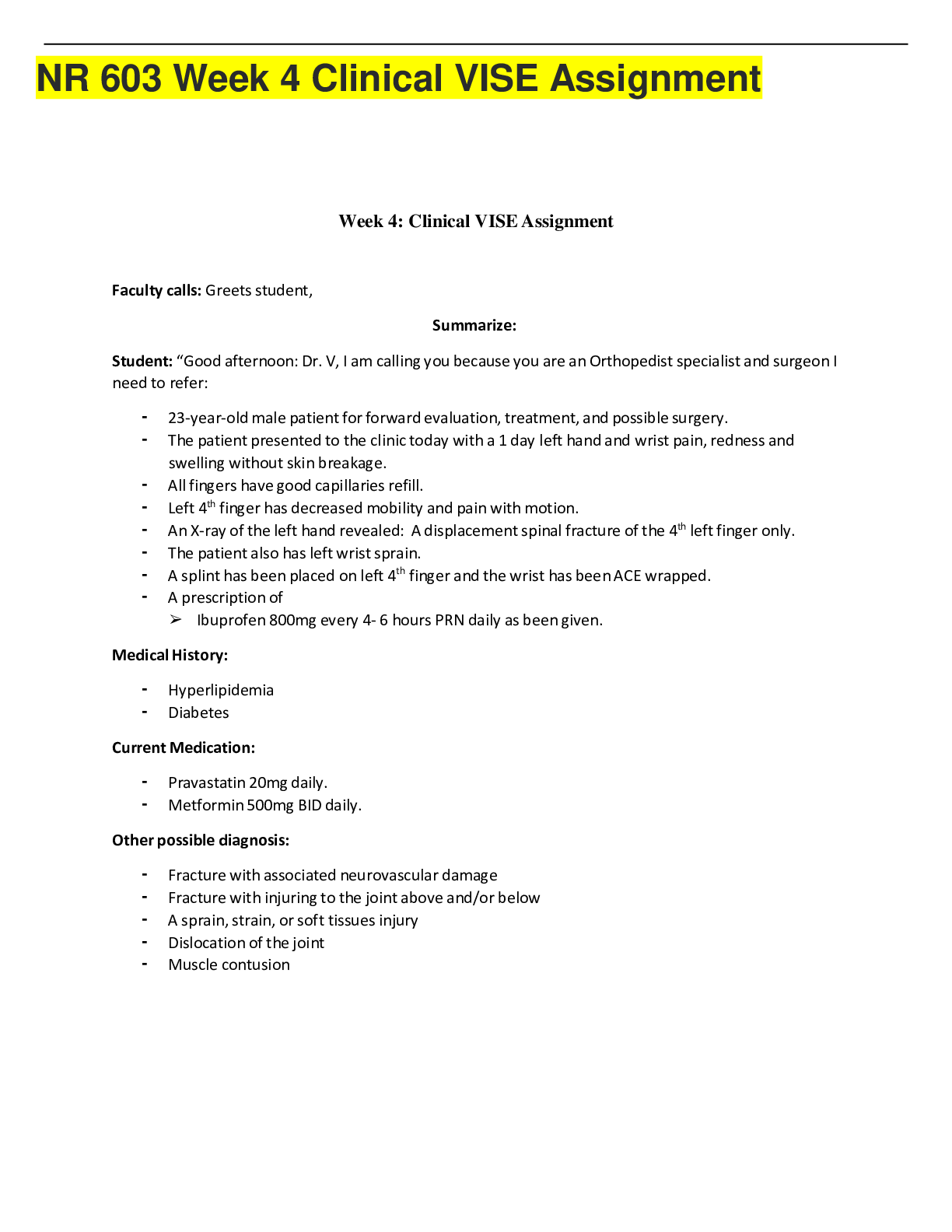*NURSING > EXAM > Chamberlain College of Nursing; NURSING NR 603 Week 3 Exam latest updated (Answered) (All)
Chamberlain College of Nursing; NURSING NR 603 Week 3 Exam latest updated (Answered)
Document Content and Description Below
Chamberlain College of Nursing; NURSING NR 603 Week 3 Exam latest updated (Answered) Mr. Brown, a 45-year-old African American male, has elevated lipids. What should the nurse practitioner do next?... a. Prescribe a statin daily. b. Check a thyroid stimulating hormone (TSH) level. c. Check a second measurement to confirm diagnosis. d. Order a stress test. . Which of the following medications may have an unfavorable effect on a hypertensive patient's blood pressure? a. Lovastatin b. Naproxen c. Inhaled fluticasone d. Amoxicillin Which group of medications would be detrimental if used to treat a patient who has heart failure? a. ACEIs b. Calcium channel blockers c. Diuretics d. Beta blockers A patient with hypertension has been diagnosed with gout. Which home medication may have contributed to this episode of gout? a. Verapamil b. Metoprolol c. Lisinopril d. Furosemide What group of BP medications should be discontinued immediately if pregnancy occurs? a. Calcium channel blockers b. Loop diuretics c. ACEIs d. Beta blockers What are the classic symptoms of DVT? a. Heaviness in legs, burning and throbbing, muscle cramps b. Swelling, pain, and discoloration in lower extremity c. Leg numbness or weakness, coldness in feet, pain and cramping in leg and buttocks d. Leg pain with walking, numbness and tingling in legs, pain in buttocks Why are the carotid arteries assessed for bruit? a. It is indicative of generalized atherosclerosis. b. To listen for a pulse c. To assess heart rhythm d. To determine risk of stroke What is a common side effect of thiazide diuretics in males? a. Ringing in the ears b. Frequent urination c. Erectile dysfunction d. Hypokalemia An older adult who has hypertension also has osteoporosis. Which antihypertensive agent would have the secondary effect of improving her osteoporosis? a. ACEIs b. Beta blockers c. Calcium channel blockers d. Thiazide diuretics In older adults, the three most common ailments are: a. Lung cancer, heart disease, COPD b. Arthritis, asthma, osteoporosis c. Hearing loss, hypertension, arthritis d. Hypertension, heart disease, arthritis An older adult has renal insufficiency, hypertension, osteoarthritis, hypothyroidism, and varicose veins. Which medication should be avoided? a. Acetaminophen b. Beta blockers c. NSAIDs d. Low dose aspirin The correlation between blood pressure and age greater than 60 years is that as age increases: a. As age increases, blood pressure lowers. b. As age increases, systolic blood pressure rises, diastolic blood pressure stays the same. c. As age increases, both systolic and diastolic blood pressures stay the same. d. As age increases, systolic blood pressure increases, but diastolic blood pressure decreases. The lipid particle with the greatest atherogenic effect is: a. cholesterol. b. HDL. c. LDL. d. triglycerides. A 55-year-old male is obese, does not exercise, and has hyperlipidemia. His average blood pressure is 150/90 mmHg. How should he be managed today? a. He should be given low-dose thiazide diuretic. b. An ACE inhibitor is appropriate. c. Lifestyle modifications are appropriate. d. He should receive an ACE inhibitor and thiazide diuretic An 80-year-old female who is otherwise well has the following blood pressure readings. 178/70 How should she be managed pharmacologically? a. Thiazide diuretic b. ACE inhibitor c. Calcium channel blocker d. Angiotensin receptor blocker 74-year-old patient has peripheral artery disease (PAD). Which item listed below is an important non-modifiable risk factor for PAD? a. Cigarette smoking b. Hyperlipidemia c. Diabetes d. Alcohol consumption A 60 year old male with a history of type 2 Diabetes and HTN comes in for a follow up blood pressure check to evaluate the recent medication/diet/exercise plan you prescribed at his visit 3 months ago. His BMI is 20. His Blood pressures sitting and standing are: 138/80 and 132/76 respectively. What is the best analysis of the prescribed treatment plan? a. His blood pressure is within JNC 8 guidelines so no adjustments will be made at this time b. his blood pressure is within JNC 8 guidelines but there should be less variability with position change c. His blood pressure is not within JNC 8 guidelines and there should be less variability with position change d. His blood pressure is NOT within JNC 8 guidelines and therefore his therapy needs to be increased You are reviewing the labs of a 50 year old female patient who presented to you for a physical exam. You note, upon review of her labs, that her triglycerides are 670. Triglyceride levels over 500 raise immediate concern for which of the following disorders? a. liver failure b. acute pancreatitis c. myocardial infarction d. pulmonary embolism A 44 year old male patient presents to the clinic for evaluation of an episode of chest tightness that radiated to his back that he had earlier in the day when he was out for a walk. He states that once he came home and sat down, the chest tightness resolved. What is the most likely cause of his chest tightness? a. Dissecting aortic aneurysm b. Angina pectoris c. Gastroesophageal disease d. Pancreatitis exacerbation A 52 year old caucasian male with a past medical history of COPD comes in for follow up on his stage 2 HTN. Hydrochlorothiazide is at the maximum dose and a new medication needs to be added. Which medication would be the best second line therapy? a. A calcium channel blocker such as Cardizem b. An Ace inhibitor such as Lisinopril c. A beta blocker such as Metoprolol d. An alpha 1 receptor blocker such as Cardura Which of the following drugs does the 8th Joint National Committee (JNC8) 2014 Evidence Based Guidelines for the Management of High Blood pressure in adults recommend for the treatment for Caucasian males with microalbuminuria? a. Diuretics b. Angiotensin-Converting enzymes (ACE inhibitors) c. Calcium channel blockers d. Beta blocker Exercise Tolerance Test (ETT) is the first line approach to detecting CAD in stable patients. However ETT is contraindicated for some patients. Knowing when to consult with specialists is an important part of NP practice. Which patient should be referred to cardiology prior to ordering an exercise tolerance test? a. 60 year old male with cardiac chest pain and high cholesterol b. 60 year old male with cardiac chest pain and a history of smoking c. 60 year old male with cardiac chest pain and symptomatic congestive heart failure d. 60 year old male with cardiac chest pain, a history of diabetes and a BMI of 28 A 60 year old female patient presets to the clinic stating she had right arm and jaw pain about 2 hours ago along with "sweating" and shortness of breath. An EKG is performed immediately and reveals ST elevation in several leads. This clinical picture is consistent with: a. This is a non-specific finding b. Acute MI c. Angina d. A deconditioned adult A sedentary 58 year old African American female is here for her annual visit. Her VS are BP 130/70, HR 82, RR 18 BMI 30 Ht 5.2, works as an accountant in a law firm. Her past medical history includes and she states she'd like to begin training for a 10k marathon with some ladies at work. Per ACA/AHA guidelines your recommendations include a. CBC, echocardiogram b 12 lead EKG only c. 12 lead EKG and an exercise stress test d. No intervention as she has no identifiable risk factors Exercise stress test results have a higher false positive rates in women then men because: a. women cannot always reach the endurance needed. b. women are more likely to have a single vessel disease. c. women are more likely to have multi-vessel disease. d. women need to have dobutamine tests, not exercise stress tests. A 60 year old woman comes into the clinic complaining of nausea, shortness of breath and a dull pain in the middle of her back while playing tag in the yard with her granddaughter yesterday. Her past medical history includes CAD, Type 2 DM, and HTN. Lab work reveals negative troponins. The most appropriate diagnostic testing includes: a. exercise stress test. b. single proton emmission CT. c. stress test with imaging. d. echocardiogram. A 58 year old male presents to the clinic with a several year history of uncontrolled hypertension. You perform your physical assessment. Which group of physical findings is commonly seen in target organ change in uncontrolled hypertension? a. Retinopathy, nephropathy, and peripheral neuropathy b. Bruising earily, nausea, ascites c. Nausea and vomiting, muscle cramps and twitching, mental dullness d. AV nicking, bibasalar crackles, and hepatomegaly This hypertensive drug is the first choice for diabetic and renal failure patients per National Guidelines: a. ACE Inhibitors b. Calcium channel blockers. c. Thiazide diuretics d. Beta blockers The leading cause of death for women in the United States is: a. breast cancer. b. heart disease. c. cervical cancer. d. stroke. An 82 year old obese female patient presents to the clinic complaining of gradually increasing shortness of breath, weight gain of 4 pounds in the last week and atrial fibrillation on EKG. The most likely cause of her symptoms is: a. pulmonary edema. b. left sided heart failure. c. right sided heart failure. d. asthma exacerbation. [Show More]
Last updated: 1 year ago
Preview 1 out of 10 pages

Reviews( 0 )
Document information
Connected school, study & course
About the document
Uploaded On
May 14, 2022
Number of pages
10
Written in
Additional information
This document has been written for:
Uploaded
May 14, 2022
Downloads
0
Views
33

